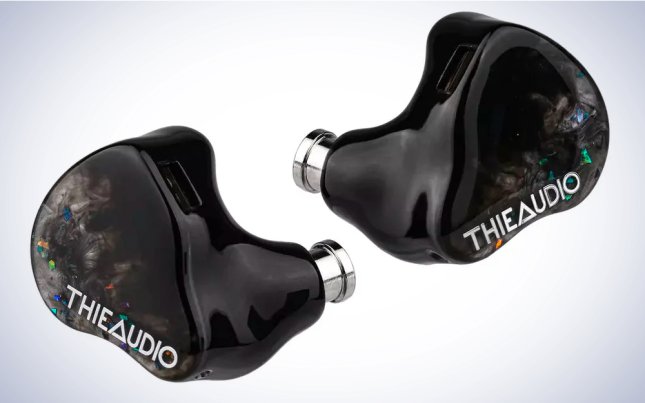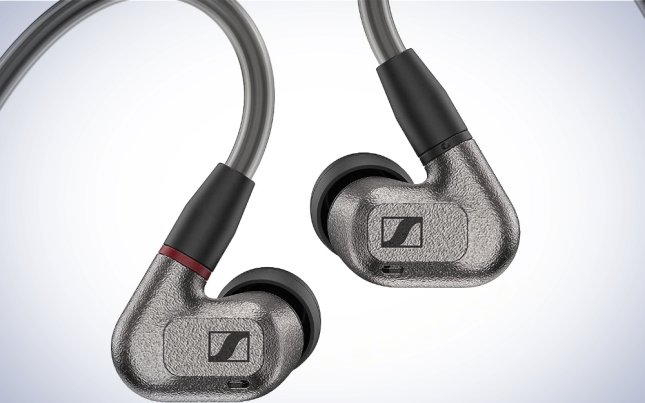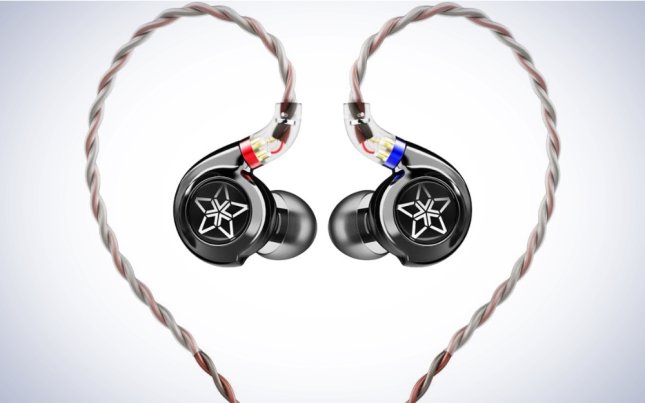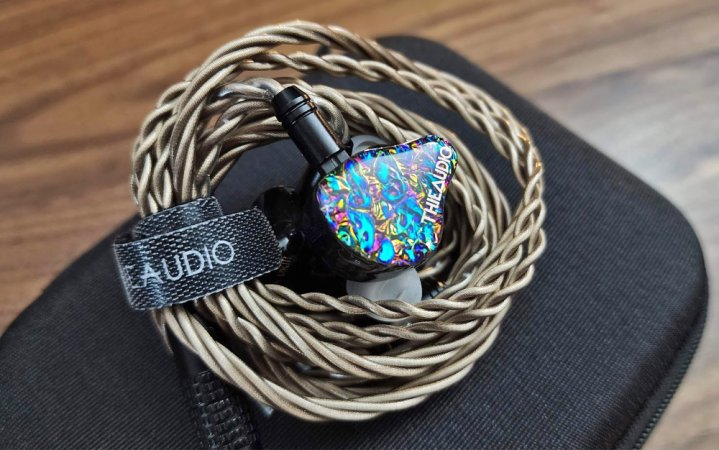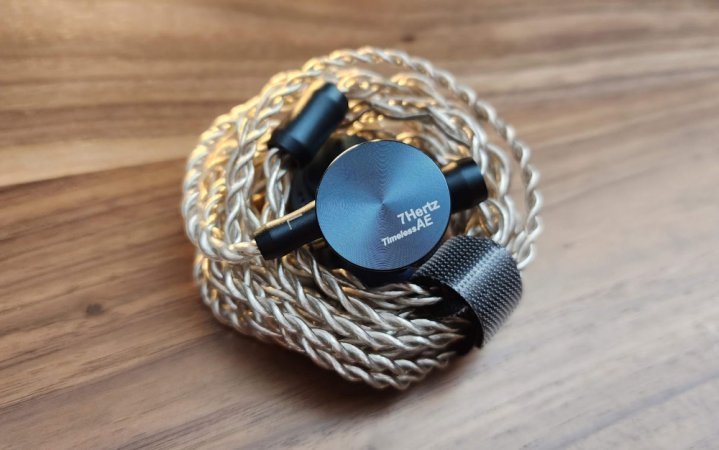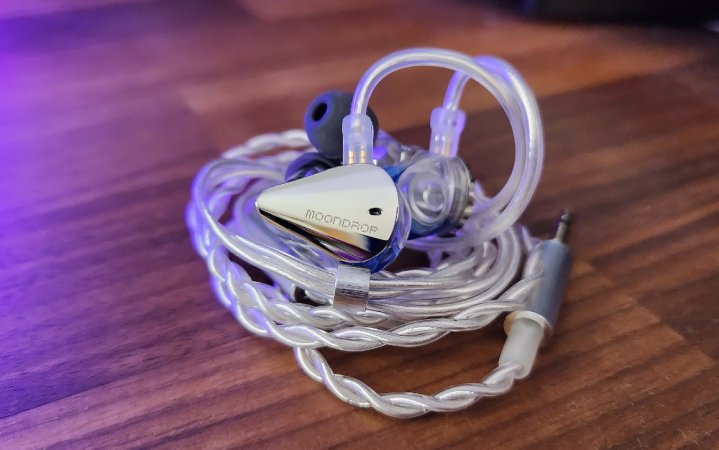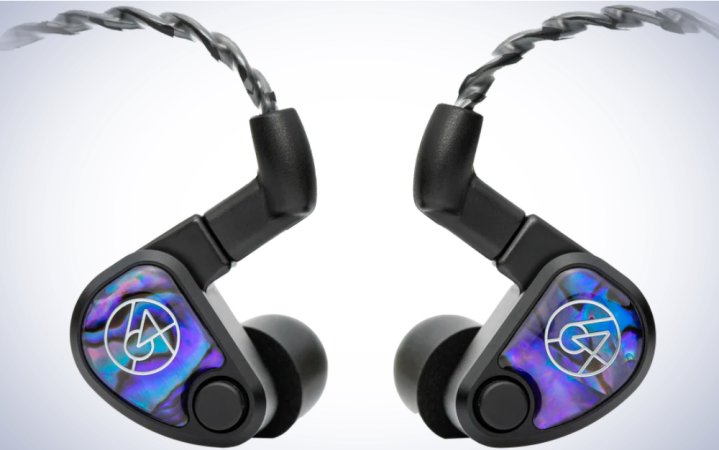We may earn revenue from the products available on this page and participate in affiliate programs. Learn more ›
Listening to a great pair of wired in-ear monitors (IEMs) for the first time can be a revelatory experience. Low profile and portable, they’re perfect for taking on the go and offer a huge leap in resolution from TWS earbuds without attracting the same attention as a larger pair of over-ear headphones. The IEM market is surging, which means competition and innovation are hot. If you’re looking for a great listening experience, you can find something for everyone’s taste among the best IEMs, even on a tight budget.
In-ear monitors have experienced an upswing in popularity over the last several years. Unlike the best wireless earbuds, IEMs still use a cable and put sound quality at the top of their priority list. You’ll need a dedicated digital audio player, a smartphone with a headphone jack, or a portable DAC to use them, and microphones and software-based features like active noise cancellation are reserved for the best ANC earbuds. But when it comes to richness, detail, and style, a great pair of IEMs is what you need. With so many options, finding the right pair for you can be challenging, so we’ve done the research for you. These are still some of the best IEMs in 2024.
- Best overall: Thieaudio Monarch MKIII
- Best planar magnetic: 7Hz Timeless AE
- Best for single dynamic driver: Sennheiser IE 600
- Best hybrid: Moondrop Blessing 3
- Best value quadbrid: Kiwi Ears Quintet
- Best premium: 64 Audio Volur
- Best all-balanced armature: FiiO FA19
- Best for live performers: Ultimate Ears Premier
- Best for the on-the-go studio: Etymotic ER4SR
- Best IEM accessory: iFi Go Pods
- Best budget: FiiO FH11
How we chose the best IEMs
I began covering technology as a budding tech critic in 2015. In 2018, I began covering personal audio for the classic PC gaming and tech site, MMORPG.com, as the Hardware and Technology Editor. Since then, I’ve covered personal audio products for numerous websites, including Tom’s Hardware, IGN, and right here at Popular Science. Collecting, testing, and enjoying IEMs has become a passion of mine, leading to a collection of nearly 60 different sets, upwards of a dozen DACs and amps, and more digital audio players than any one man should own at a time. I love IEMs and deeply appreciate the subtle and not-so-subtle differences between them.
To select the best IEMs of the year, I went back through more than 25 pairs I tested and compared them with a mix of professional and user reviews, as well as input from fellow IEM enthusiast, and Popular Science Editor, Tony Ware. Because determining the “best” of any IEM is always subjective, I broke this list into 10 categories segmented by price and design. Within that framework, I considered the quality of the drivers, fit and comfort, frequency response, tuning, and how each performed on a technical level.
The best IEMs: Reviews & Recommendations
Now that you know what to look for, you’re ready to choose something that meets your needs. What you’ll find below is a collection of IEMs that represent the best each category has to offer, allowing you to find the best IEMs for you or someone who loves music as much as you do.
Best overall: Thieaudio Monarch MKIII
Pros
- Fast, detailed, and powerful bass
- Fantastic detail and soundstage
- Airy yet non-fatiguing treble
Cons
- Sparse accessories
- Large size
Specs
- Price: $999
- Drivers: x2 dynamic drivers, x6 balanced armatures, x2 electrostatics
- Frequency response: 20Hz – 80kHz
- Sensitivity: 99dB/mW
- Impedance: 18 ohms
The Thieaudio Monarch MKIII is the third version of this popular pair of earphones and is its most well-rounded and crowd-pleasing yet. It uses a whopping 20 drivers between its two earpieces—each a trifecta of two dynamic drivers, six balanced armatures, and two electrostatics. This combination allows it to deliver a sound signature that is full and dynamic, rich in detail, and with an impressively wide soundstage. These earphones don’t come cheap, but they’re absolutely class-leading and outperform pairs I’ve heard that cost a grand more, so they manage to feel like your best value because of it.
The secret sauce comes in how well utilized each of its drivers is. The bass has been enhanced from the Monarch MKII with a second dynamic driver. Both drivers are enclosed in an isobaric chamber within each earpiece, creating a subwoofer-like effect in your ears. At the same time, the electrostatics add air and sparkle to the listening experience, while the spacious mids are carried effortlessly by the customized balanced armatures.
The final product is a sonic treat for your ears. The Monarch MKIII has a full and rich sound that’s immediately engaging. The bass is fast and full of realistic texture, yet doesn’t impede on the mids. Vocals are natural, detailed, centered, and slightly forward. You’ll hear every rasp, every tiny breath, and if you’re a fan of instrument detail, look out: These earphones hide nothing, particularly with string instruments and pianos. The treble is smooth yet sparkly, with natural decay to cymbal crashes and hi-hats. The electrostatics add air and atmosphere, enhancing their wide, deep soundstage. In short, prepare to be wowed.
If these earphones have an Achilles’ heel, it’s that fitting all of those drivers into each earpiece demands a large size that may not be comfortable for smaller listeners. Thieaudio includes a sparse selection of ear tips in the box, but three pairs of silicone and foam tips help you find a proper fit. Their size is a sacrifice we’re willing to make, however, because these IEMs are fantastic.
Best planar magnetic: 7Hz Timeless AE
Pros
- Improved bass and soundstage from the original
- Excellent detail retrieval
- Included modular cable
Cons
- Potential fit issues due to large faceplates
Specs
- Price: $259
- Drivers: 14.2mm planar magnetic
- Frequency response: 5Hz – 40kHz
- Sensitivity: 104dB/mW
- Impedance: 14.8 ohm
The original 7Hz Timeless earned a cult fanbase, and for good reason: they were one of the first pairs to deliver a true planar-magnetic listening experience in an IEM format at a reasonable price (planars typically being a type of driver found in expensive full-sized flagship headphones and costly earphones). The Timeless AE is a collaboration IEM with the popular AliExpress audio store, Angelears, and addresses the biggest criticism against the original: bass. While the original Timeless was highly regarded for its excellent detail and crisp sound signature, it leaned into the mids and highs, leaving low-end a touch thin. That’s no longer the case with the Timeless AE, making this the most well-rounded and fun planar-magnetic earphone you can buy today.
The Timeless AE doesn’t stop there, though. This new version also smooths out the upper treble, removing some peaks that some listeners found harsh. It also comes in a fresh blue color and includes a modular cable with both single-ended and balanced terminations. Its circular faceplates have been known to cause some fit issues in smaller ears since its inner side is much smaller and more contoured; most listeners will find these to be just as comfortable as standard-sized IEMs.
Best for single dynamic driver: Sennheiser IE 600
Pros
- Cohesive, smooth, yet detailed sound signature
- Excellent fit
- Detachable balanced cable
Cons
- Texture can cause comfort issues
- Included tips are poor
Specs
- Price: $599
- Drivers: 7mm TrueResponse dynamic driver
- Frequency response: 4Hz – 46.5kHz
- Sensitivity: 118dB/mW
- Impedance: 18 ohms
Few audio brands are as highly esteemed as Sennheiser, but while its headphones are widely regarded as some of the best you can buy, its IEMs have been more hit or miss. The IE 600 is absolutely a hit, delivering well-balanced bass and exceptional clarity with the cohesion only a single dynamic driver can provide. In a word, the IE 600 is smooth, and it’s that very quality that will have you carrying it with you so it can carry you through the day.
With a velvety midrange that benefits vocals and lush instrumentation alike, it’s pure audio enjoyment. Well, that and exceptional comfort. Since there’s only one driver to fit into each earpiece, they can be quite small and low profile, with custom dual-chamber system used to tune the tone and tone the tunes. They’re also robust enough to withstand the wear and tear of daily use since the housings are made of 3D-printed ZR01 amorphous zirconium—an alloy that’s three times harder than steel—and they have a detachable cable that can be replaced or upgraded. Reviewers at another site claimed some irritation from the hand finish, but this doesn’t seem widely reported elsewhere. What is echoed is that the ear tips are sub-par, so you may want to invest in some aftermarket tips to make the most of the IE 600 (as seen in the image above).
Are you a highly analytical listener and want to eke out the tail end of every transient? For the ultimate in resolution, you can step up to the Sennheiser IE 900 at $899.
Best hybrid: Moondrop Blessing 3
Pros
- Detailed, textured sub-bass
- Excellent layering and presentation
- Smooth yet crisp treble
Cons
- Large size
Specs
- Price: $319.99
- Drivers: x2 dynamic driver, x2 balanced armature
- Frequency response: 10Hz – 30kHz
- Sensitivity: 120dB/mW
- Impedance: 14.8 ohms
The Moondrop Blessing 2 was a seminal IEM for the affordable audiophile hobby, representing the very best of what ChiFi could produce: outstanding sonics at a reasonable price. The Moondrop Blessing 3 is as worthy of a successor as we could have hoped for, delivering a crisp, detailed listening experience with newfound low-end body. It’s a stellar example of what hybrid IEMs do best: splitting the frequencies into ranges each driver can specialize in.
The Blessing 3 builds on its predecessor by adding a second 10mm dynamic driver to the mix and integrating it in what Moondrop calls its H.O.D.D.D.U.S. system. That’s Horizontally Opposed Dual Dynamic Drivers Unit System, which in human terms means the dynamic drivers are positioned back to back, allowing their magnetic fields to cross over and supplement one another. The result is more, better bass. The mids and highs are split between four balanced armatures per side using electronics and dedicated sound tubes that lead directly to the nozzle. Vocals are silky, instruments are natural, and the presentation is spacious and realistic.
One thing Moondrop didn’t make much headway in is its large size. Like the Thieaudio Monarch MKIII, these are big IEMs that won’t work well for smaller listeners. For average ears and up, it’s an excellent choice that highlights why hybrid IEMs have become so popular.
Best value quadbrid: Kiwi Ears Quintet
Pros
- Palpable and projected performance that competes above its price range
- Unique driver array that stays gelled during dynamic swings
- Excellent detail retrieval for an affordable IEM
- Easy to drive, very source-friendly
Cons
- Highs may sound too zesty for the treble-sensitive
- Not the most spacious soundstage
Specs
- Price: $219
- Drivers: x1 dynamic driver, x2 balanced armatures, x1 planar-magnetic driver, x1 piezoelectric (PZT) bone conductor
- Frequency response: 20Hz – 30KHz
- Sensitivity: 106dB/mW
- Impedance: 32 ohms
If you want to hear more but not pay more, brands like Kiwi Ears are using trickle-down tech in ways that don’t push up prices. A quad-driver configuration used to be serious enthusiast territory, but is now within entry-level reach. That doesn’t mean rudimentary sound, however. A combination of a diamond-like carbon (DLC) dynamic driver, two balanced armature (BA) drivers, a micro-planar transducers (MPT) tweeter system, and a piezoelectric (PZT) bone conductor sounds like it could be incoherent, but ends up sounding quite articulate without being overly aggressive.
Packed within a snugly fitting 3D-printed resin shell, behind logo-embossed anodized metal faceplates, this five-driver-per-ear configuration offers a shallow U-shaped tuning. Vented, there’s no excess pressure or driver flex. Bass is warm without being wooly, mostly controlled while hitting perceivable subbass when called upon. The low-end buoys the lower mids slightly but not so much as to obscure texture. There’s still plenty of airy energy, with instruments isolated and impactful within the adequate soundstage. Still, the Quintet produces engaging technicalities and authentic timbre thru the upper treble, which can be a little shouty, but excess sparkle can be tempered through warmer sources, eartip rolling, and/or opting for a third-party 2-pin pure copper cable over the included 4-core oxygen-free silver-plated copper cable. However, if you’re not adversely sensitive to sizzle the stock cable is solid and free of microphonics.
The Kiwi Ears Quintet is a crisp package, both in its look and while listening. There is appropriate depth and detail, with instruments punchy and well-positioned. You could spend more, but the Kiwi Quintet supports a balanced sound and budget with aplomb.
Best premium: 64 Audio Volur
Pros
- Excellent for mid-range instruments and vocals
- Tight, fast, and well-textured bass
- Effective tuning nozzles to adjust the sound to your preference
Cons
- Upper treble can be a bit hot
Specs
- Price: $2,499
- Drivers: x2 dynamic drivers, x8 balanced armatures
- Frequency response: 5Hz – 22kHz
- Sensitivity: 103dB/mW
- Impedance: 6.3 ohms
Made in the USA, the 64 Audio Volur is a showcase of innovation and craftsmanship. This hybrid IEM uses a 10-driver array consisting of two dynamic drivers and eight balanced armatures. There are no less than three patented systems at play in its design, and one of the most unique bass systems we’ve encountered yet. It also features replaceable tuning nozzles to fine-tune the sound for your exact preferences. The result is earphones offering some of the best low-end out there, crisp and detailed mids, and sparkling highs.
The bass is one of the most remarkable and interesting aspects of the Volur. Its two dynamic drivers are positioned in a true isobaric chamber, one of which is sealed off, increasing power, clarity, and lowering the noise floor, all before hitting a custom low-pass filer. The highs are just as innovative, utilizing a patented tubeless driver system that 64 Audio calls Tia, or Tubeless In-Ear Audio. The highs travel through a waveguide into acoustic chambers and hit the ear more naturally.
Despite having 10 drivers, they’re small enough to fit in most ears and are made of aluminum to last a lifetime. They’re also gorgeous with reworked gem-like faceplates. The biggest downside, apart from being priced firmly in splurge territory, is that the highs can sound slightly hot on some tracks. But since there are four tuning nozzles that each cater to different listening tastes, even this isn’t a major drawback. The Volur is pricey but worth trying first-hand.
Best all-balanced armature: FiiO FA19
Pros
- Outstanding detail
- Tuning switch provides two different sound signatures
- Great for musicians, as well as audiophiles
Cons
- Large fit may not be comfortable for listeners with smaller ears
Why it made the cut: These impressive in-ears deliver clarity and versatility in a refined package.
Specs
- Price: $999.99
- Drivers: Balanced armature
- Frequency response: 20Hz – 40kHz
- Weight: 7 grams (each ear piece)
- Sensitivity: 106 dB
- Impedance: 10 ohms
FiiO has been a rising star in the audiophile world for some time, getting its start with simple portable amps and DACs to now delivering some of the best value earphones and IEMs and listening devices on the market. The FA19 is its latest set using only balanced armatures (BAs) and it earns our pick thanks to its combination of performance and versatility.
The FA19 features a whopping 10 Knowles balanced armatures per side, or 20 tiny speakers total, to create their sonics. A combination of electronic and physical crossovers split the frequencies between these drivers, allowing each to focus on a specific frequency band instead of being a jack of all trades. As a result, these earphones offer exceptional clarity and detail while also being tuned very well to bring out the best in your music.
FiiO pulled out all the stops with the technology in this set. It uses a negative feedback airflow system that enhances the low end while improving their comfort. A notch filter helps to fill out the treble and remove sibilance and the “over-crisp” quality balanced armatures can sometimes produce. It also features a tuning switch that changes its sound profile.
This switch allows the FA19 to shift from a flat reference sound profile, perfect for monitoring, to a HiFi mode that adjusts the frequency response to FiiO’s custom tuning. While the former is designed to highlight details through the entire frequency range without overemphasizing any one element, the HiFi mode enhances the bass and mids for a more energetic sound. This allows the FA19 to pull double duty as a stage IEM for performing musicians or bedroom recording artists as well as deliver a blissful bubble curated for audiophiles. The FA19 is a fantastic set, but with 10 BAs per side, it’s certainly not the smallest. FiiO has engineered its nozzle and shell to accommodate a better fit, but there’s no way around its large size. Assuming you don’t have exceptionally minute ears, however, we still expect you can find a secure fit, even if they stick out a bit more than usual.
Want to spend half as much but still feel like you’re getting a rich experience? The DUNU SA6 MKII proves that an all-BA set can deliver powerful bass when tuned correctly. At the same time, these IEMs deliver incredible detail and one of the most spacious listening experiences you’ll find under $600. With six drivers embedded into each earpiece, DUNU splits its frequencies into the classic lows, mids, and highs but dedicates two drivers to each. Vented Sonion woofers handle the lows while customized Knowles drivers drive the mids and highs for a fine-tuned listening experience that’s smooth yet rich in immersive detail and tonally sweet.
Much like the FA19, the SA6 MKII’s trump card is the tiny tuning switch built into the back of each earpiece. Toggled on, this enables Atmospheric Immersion Mode for cinematic bass. In the off position, the sound field is more balanced, allowing you to hear every breath and slide across the fretboard. If there’s one criticism to be levied against it, it’s that the sound can sometimes sound too crisp with a subtle etched quality akin to applying sharpening to a photograph (a classic trait of balanced armatures). However, this hardly diminishes the listening experience and can even be enjoyable if you’re a fan of crisp details. These earphones are simply a fantastic choice for fans of carefully considered balanced armature configurations.
Best for live performers: Ultimate Ears Premier
Pros
- Outstanding clarity and detail
- Totally personalized
- One of the most EQ-friendly IEMs
- Isolating, with optional environmental passthrough
Cons
- Deep fit can be uncomfortable initially to the unaccustomed
- Requires a trip to an audiologist at extra cost
- Don’t sit flush with your ear
- Extremely expensive
Specs
- Price: $2,999
- Drivers: x21 balanced armatures
- Frequency response: 5Hz-40kHz
- Sensitivity: 120dB/mW
- Impedance: 15 ohms
When you’re performing live with other musicians, hearing the mix and where you fit within it is critical. When lesser earphones won’t do, the Ultimate Ears (UE) Premier stands ready as the premium, fully customizable option (aesthetically and sonically) that is just as individual and professional as your own musical style. These earphones are custom-made using second-bend impressions of your ear canal (or 3D scans at select locations), so when they arrive at your door, they perfectly match your ear—and no one else’s. This provides the very best in sound isolation (up to 26dB) to protect your hearing while also allowing you to hear everything true to life. The Premier also offers (for a fee) an optional Ambient Feature, a small plug that can be undone to allow 12dB of environmental bleed to hear the stage and crowd and keep more in touch with both.
These earphones use an astounding 21 balanced armatures per ear, with a five-way passive crossover, to deliver their sound. While that might seem like overkill, UE sequesters these clusters into intricately interlaced tubes dedicated to sub-sections of the frequency spectrum that phase align for improved accuracy. There are two dual sub-low speakers (4 drivers), dual mid-low diaphragm groups (8 drivers), a quad mid-frequency setup (4 drivers), as well as one True Tone Plus driver and a quad Knowles Super Tweeter (4 drivers) that extends to 40kHz specifically for overtones and upper-level harmonics, so instruments ring true to life in your ears.
The stock tuning is midrange forward without being congested, sacrificing neither distortion-free low-end nor extended yet unfatiguing highs but rather maintaining the most weight in the range where music truly lives. From growl to gossamer, texture and tonality are rich and fully realized. Ultimately, however, what the Premier’s bottomless well of headroom allows is for the monitor engineer to carve a curve tailored to each musician, isolate a band within the band. If you need to sync to sequencing or track trailing notes, the UE Premier offers percussive snap and effortless transients, definition and directional cues. Similarly, audiophiles tired of seeking a Goldilocks house sound and who aren’t anti-EQ can sculpt their perfect response and take advantage of the bounty of instrument separation. The UE Premier’s strength is that it can play to yours (achieving its full potential with some processing or an experienced engineer).
Forty-two total drivers and fully molded earpieces don’t come cheap, and there’s more legwork with this pair than any other set on our list. You’ll need to visit an audiologist for a scan of your ears, which adds additional time and cost to this already pricey set (and there’s no option for resale with customs). Then you wait the 15 business days (on average) for your set to be produced and delivered. The final product is made entirely of 3D-printed acrylic, which can feel uncomfortably stiff and deep if they’re your first molded pair. However, for isolation, clarity, and a locked fit on stage, plus an IPX67 (waterproof) connection system and SuperBAX cable for long-term durability (and things get sweaty under the stage lights), these are exquisite and a worthwhile investment.
Best for the studio: Etymotic ER4SR
Pros
- Detailed and accurate sound
- Very small yet robustly made
- Designed with sound engineers in mind
Cons
- Deep fit can be offputting
- Require more power to drive to full volume
Specs
- Price: $299.99
- Drivers: Single balanced armature
- Frequency response: 20Hz – 16kHz
- Sensitivity: 98dB/mW
- Impedance: 45 ohms
If mixing and mastering is your livelihood, then you need accuracy. The Etymotic ER4SR is designed with exactly that purpose in mind. The sound signature on these IEMs was crafted with careful attention to balance across all of the frequencies. Understanding that the way sound waves hit your ears from an in-ear monitor is far different than a traditional studio monitor, these IEMs fully compensate for those differences, ensuring you hear the music exactly as it was produced, every time. Of course, if you want a little more energy, the ER4XR offers exactly that with a smidge more bass while still being accurate throughout the mids and highs. Just be prepared to give either pair a bit of extra power because they’re harder to drive than most other earphones.
Etymotic is a bit of an icon in the in-ear monitor world, not only for its reference sound signature but also for its unique deep-insertion fit. These earphones offer your choice of triple-flange or foam ear tips and fit deeper in the ear canal for impeccable sound isolation. It’s great for blocking out the world to focus on your mix but takes some getting used to, a learning curve that some people never fully come to grips with. However, for sound engineers looking for balanced monitors, it’s worth acclimating to.
Best IEM accessory: iFi GO pods
Pros
- Enough power to drive even demanding IEMs
- Excellent high-res audio support
- Long battery life
Cons
- Bulky
- Large charging case
Specs
- Price: $399
- Output power: 120mW into 32 ohms
- Frequency response: 10Hz – 20kHz
- Bit-depth/sample rate: 32-bit/96kHz
- Format support: LDAC, LHDC/HWA, aptX Adaptive, aptX, AAC, SBC
- Battery Life: 7 hours + 30 hours with the case
Audiophiles may seem to love their cables, but make no mistake: we would go wireless if we didn’t have to sacrifice audio quality to get there. That’s where the GO pods from iFi Audio come in. This novel accessory adds a high-quality DAC and amp into a Bluetooth ear hook, complementing it with a full assortment of high-resolution wireless codecs. It’s as close to zero compromises as wireless adapters come and allows you to finally enjoy high-quality audio without being tethered to your phone or DAP.
We believe iFi Audio has been making some of the best DACs and amps for years, and all of that know-how has made its way into the GO pod. They’re powerful enough for any IEM, with automatic impedance detection and up to 120mW of total output power/output voltage of 4V, and are rated for an impressive seven hours of use with another 30 provided by the charging case. They offer interchangeable loops with connectors for both MMCX and 0.78mm 2-pin IEMs included in the package and Pentaconn, T2, and A2DC connectors available separately. With an equally high-quality stream, the GO pods’ Cirrus Logic MasterHIFI and Qualcomm’s QCC5144 Bluetooth 5.2 chipset facilitates resolution up to an impressive 32-bit/96kHz through connections including LDAC, LHDC, aptX Adaptive, as well as traditional AAC and SBC for standard streaming quality. Attached to IEMs such as the Campfire Audio Solaris Stellar Horizon pictured above, reproduction is as stable as it is supple, appropriately authoritative with a bombastic, emotional, and agile response.
At its core, the iFi GO pods are adapters and are more bulky than traditional earbuds. That’s also true of the charging case, which we hope slims down in a future version. Still, for using your IEMs on the go, they’re IPX5-rated, have a built-in microphone utilizing Qualcomm’s cVc noise suppression technology, and are a wonderful choice that essentially turns any upscale earphones found on this list into true wireless.
Best budget: FiiO FH11
Pros
- Great value
- Durable aluminum design
- Bass rich yet detailed sound
Cons
- Bass can bleed into the mids
- Long nozzles can present a comfort issue
Specs
- Price: $54.99
- Drivers: 10mm dynamic driver, balanced armature
- Frequency response: 20Hz – 20kHz
- Sensitivity: 111dB/mW
- Impedance: 24 ohms
Though it built its reputation on portable amplifiers and accessories, FiiO has quietly made some of the best value IEMs for years. If you’re on a budget, the FiiO FH11 should be on your must-buy list. They’re made entirely of metal to withstand the rigors of daily use, include a replaceable cable for even more peace of mind, and, most importantly, sound great for a wide range of music, movies, and games.
These conch-inspired earphones are the second half of FiiO’s budget-minded releases this year, with the other half being the FD11. Unlike that model, which used a single dynamic driver and opted for a milder and more neutral sound signature, the FH11 uses both a dynamic driver and balanced armature for its sonics and leans into the bass for a more fun listening experience.
The FH11 uses longer nozzles, so fit may be an issue if you have particularly sensitive ear canals. The heightened bass can also make the mids sound a bit too warm at times; it’s not a problem for hip-hop or pop, but fans of jazz and classical may prefer to lower it with EQ or opt for the FD11. Overall, this is just a delightful listen and comes in at a great price.
What to consider when shopping for the best IEMs
Buying IEMs can be surprisingly complicated. There’s a lot to consider, and it can be very hard to try them for yourself ahead of time. It’s helpful to have an idea of the type of sound you’re looking for ahead of time—bass-rich, bright and detailed, great for vocals, etc.—but here are some other important things to look for when shopping.
Size and shape
IEMs are much more “personal” than over-ear headphones, and finding a comfortable fit is critical. Small IEMs are usually easy to accommodate for most listeners, especially with larger silicone or foam ear tips. Choosing an IEM that’s too large for you can cause discomfort in your ear canal and outer ear, creating fatigue and cutting your listening sessions short. To have the best experience, choose an earphone that matches your ears. If that’s not possible, you may need to invest in aftermarket ear tips that add more grip within your ear canal.
Along with this, it’s important to pay attention to the shape. The inner surface of each earpiece is the most important. Look for smooth contours and avoid hard angles that look like they may make contact with your ear. Earphones like the Plussound Allegro have inner bevels that look great but can become uncomfortable over time for some listeners. If you have smaller ears, the outer face may also be important. Some listeners find the 7Hz Timeless uncomfortable when its large circular faceplates make contact with their ears. Comfort is king with in-ears, so it should be at the top of your priority list alongside sound quality.
Drivers
The type of transducer, or driver, an IEM uses directly impacts its sound. The four main types of drivers are dynamic, balanced armature, planar magnetic, and electrostatic. While dynamic drivers are the most common and are a great all-around choice, manufacturers often mix driver types to leverage their specialties, designating certain frequencies for each. How they’re customized, or tuned, also plays a large role. Here is how they break down in general terms:
- Dynamic drivers (DD): Conical drivers driven by a powerful magnet and voice coil, similar to what you’ll find in large box speakers. These transducers are known for delivering impactful bass but can sound great across the entire frequency range.
- Balanced armatures (BA): These tiny speakers often play a supporting role, typically in the mids and highs, but can be leveraged to deliver a full-bodied sound all on their own. Popular in hearing aids, balanced armatures are known for their crisp detail.
- Planar magnetic: These drivers use a large, flat membrane traced with electrical filament and flanked by powerful magnets. Thanks to their large size and high sensitivity, planar magnetic drivers are known for their excellent clarity, speed, and detail while also having vanishingly low distortion.
- Electrostatic (EST): Electrostatics, or ESTs, are boutique drivers that cater to the ultra-high frequencies. ESTs often enhance the subtleties of the listening experience, such as the sense of air, atmosphere, and upper-level harmonic resonances.
While each driver type has its fans, there is no “best IEM driver.” Each type has strengths and weaknesses, and how the manufacturer uses each driver is often much more important than the actual driver type. With that said, some of the best IEMs use multiple types to provide the best of all worlds.
Frequency response
An IEM’s frequency response is the range of frequencies it can produce and the balance between them. This is usually simplified to the bass, mids, and treble and creates the particular flavor of sound each earphone is able to deliver. While you truly won’t know how you feel about an IEM without auditioning it, it can often be difficult to try every IEM before purchasing, so we recommend utilizing graph databases like In-Ear Fidelity and Squig.Link to get a visual impression of the balance of sound an IEM is likely to produce and how it lines up with your preferred personal audio components.
Frequency response is represented in a graph that spans from roughly 20Hz to 20kHz, the range of human hearing. IEMs are tested using sound impulses that produce a curve indicating their balance across this range. A bump in the lower frequencies means more bass, while a rise on the other end may indicate that an IEM is sharp. Interpreting graphs is challenging, so we always recommend pairing these examinations with professional and user reviews to hear how those curves translate to real life.
Price
The audio hobby is deep, and prices can extend well into the halo-tier of products. It’s not unheard of to find simple cables selling for thousands of dollars. While there is some truth to the adage “you get what you pay for,” it’s also important to note that diminishing returns are a very real part of the hobby. Many great IEMs don’t cost hundreds or thousands of dollars, and those that do may not offer the level of improvement you might expect for such an increase in price. Research any product you’re considering and look into competitors that may offer savings. Along with this, we always recommend being aware of your vendor’s return policy if it turns out you’d rather try something else.
FAQs
While IEMs can be great for gaming, over-ear headphones are often better. This is because IEMs usually have a decreased sense of space compared to over-ear headphones. Full-size cans can also have open-backs, extending the soundstage further, a trait that is still uncommon among in-ear monitors. With that said, IEMs typically offer better isolation and are much lower profile. It’s also not unheard of for IEMs to offer a wide soundstage, though this is a quality it’s wise to shop specifically for. Enabling spatial audio solutions like Windows Sonic (free with Windows) and Dolby Atmos ($14.99 on the Windows Store) are very helpful for increasing an IEM’s sense of space.
Not necessarily. The choice between headphones and IEMs comes down to personal preference. It is true that IEMs can often be a better value, especially if you’re open to purchasing from international brands like 7Hz or DUNU and storefronts like Linsoul. The IEM space is extremely competitive with new models released all the time, so the price-to-performance ratio is often higher with in-ears than over-ears.
When it comes to sound quality, yes. In order to send audio through the air, wireless earphones apply compression algorithms that decrease sound quality. While true wireless earbuds win major points in convenience, there’s no beating a dedicated wire when it comes to hearing every bit of detail in your favorite music. Ultimately, whether one is better than the other for you will depend on how much you value acoustics versus the convenience of listening wirelessly.
Final thoughts on the best IEMS
- Best overall: Thieaudio Monarch MKIII
- Best planar magnetic: 7Hz Timeless AE
- Best for single dynamic driver: Sennheiser IE 600
- Best hybrid: Moondrop Blessing 3
- Best value quadbrid: Kiwi Ears Quintet
- Best premium: 64 Audio Volur
- Best all-balanced armature: FiiO FA19
- Best for live performers: Ultimate Ears Premier
- Best for the studio: Etymotic ER4SR
- Best IEM accessory: iFi Go Pods
- Best budget: FiiO FH11
A great pair of IEMs allows you to take enrapturing sound quality anywhere you go. Finding a pair that resonates with your tastes can quickly make it one of your most satisfying purchases. Now that you know what to look for and what the best picks are today, you have the tools to find that perfect IEM and take your enjoyment to new heights (as well as new lows and plush, perfectly balanced mids).
